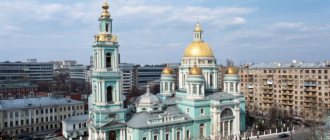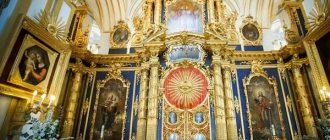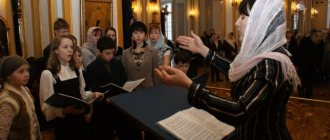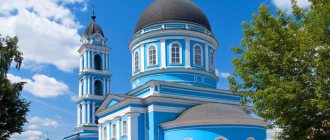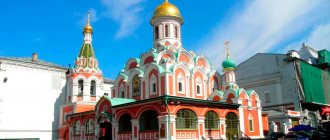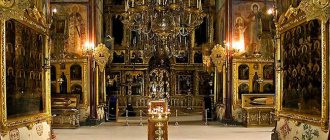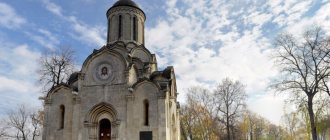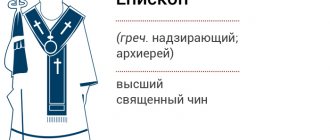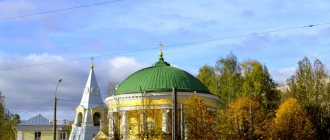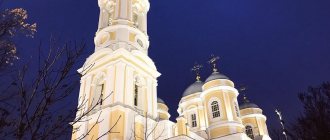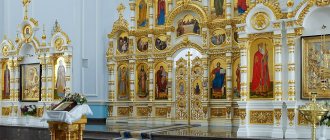According to the most common version, in the place where the Elokhov Cathedral (Epiphany Cathedral in Elohovo) , an alder forest grew in the 14th century, and the village of Elokh was located not far from it.
This word used to mean alder, and today one of the streets near the Yelokhovsky Cathedral is called Olkhovskaya, so this version has the right to life.
History of construction
The Yelokhovskaya Church has a long, difficult, and full of dramatic moments fate.
Basic period of construction
In 1698, residents of the village of Elokha erected a small prayer room made of wood, and a little later, during the reign of Tsar Peter I, a stone structure was erected on this site (1717 - 1722). In the 30s, in honor of the Annunciation of the Virgin Mary, a chapel was added to it. By the end of the 18th century, other extensions appeared - a bell tower and a refectory. But Moscow is growing rapidly at this time, it becomes crowded during services, people coming from nearby and remote areas of the city cannot get inside.
We decided to begin construction of a new large temple structure. The architect E. Tyurin was entrusted with preparing the project. There were not enough funds, so construction continued for a very long time, but services were also carried out during construction or finishing work.
Subsequent restorations
By 1845, the construction of the main part of the structure, which was crowned by five domes, was completed. With the help of parishioners, mainly thanks to donations from the merchant Shchapov, the church was completed. In 1853 it was consecrated by Philaret, Metropolitan of Moscow and Kolomna.
A few years later, the upper tiers of the bell tower were built; in the 19th century, a dome was erected on the refectory, and attics were erected on the side facades. The height from the foundation to the cross and the bell tower is 56 m, area is 1164 sq. m, can accommodate 3000 people at the same time.
Modern arrangement
The most significant restoration was carried out in the late 60s of the twentieth century, which lasted 20 years. A huge amount of painstaking work was done. The floor was replaced with marble, the gold leaf covering was updated, and the pulpit was equipped with a bronze fence. The iconostasis was restored, and the wall paintings were cleaned and strengthened. They raised the floor under the altar and soles (raise). The balconies were refurbished, adding a central one, and a room was allocated for singers. We equipped elevators and conducted a broadcast so that believers could better hear the service.
The façade and roof were repaired. We landscaped the area and reconstructed residential buildings, dining rooms, and organized a place for the blessing of water. The restoration was carried out under the leadership of the chosen headman - N.S. Kapchuk.
Briefly about the Epiphany Cathedral in Elokhov - a description for tourists and pilgrims
Address
: Moscow, Spartakovskaya street, 15
Directions:
st. metro station "Baumanskaya"
Epiphany Cathedral in Yelokhov
- a Moscow temple with the happiest fate, since even during the years of religious persecution during the Soviet era it was never closed, and worship services never stopped there. More often in everyday speech among Muscovites, the Epiphany Cathedral in Elokhov is usually called simply Elokhovsky. The first documentary mention of the Church of the Epiphany in the village of Elokhova is found in the decree of Patriarch Adrian of 1694. True, the mentioned church at that time was still wooden, and the village of Elokhovo was located outside the official border of Moscow. In 1717, the church in Elohovo was rebuilt in stone. And the Epiphany Cathedral in Yelokhov acquired its modern appearance after reconstruction in 1837-1845 according to the design of the architect E.D. Tyurin, becoming one of the largest and most beautiful in Moscow. By the way, its height from the ground to the top of the central dome is 56 meters, and its capacity is 3 thousand people.
An interesting and memorable date in the biography of the Yelokhovsky Cathedral is June 8, 1799 - the day when the future great poet Alexander Sergeevich Pushkin was baptized within its walls.
After the October Revolution and the massive closure and destruction of many Moscow churches, the Elokhov Cathedral became one of the main spiritual centers of the country. In 1938, it was awarded the status of Moscow Cathedral. And in 1945 it received the status of the Patriarchal Cathedral and retained it until 1991. And throughout the entire Soviet period of Russian history, the Epiphany Cathedral in Yelokhov was the place of enthronement of the Moscow patriarchs.
Due to its high status, shrines were moved to the Yelokhovsky Cathedral from many closed Moscow churches. Among Moscow's Christian relics that have found a new home are a particularly revered copy of the Kazan Icon of the Mother of God from the Kazan Cathedral on Red Square and the relics of St. Alexis, the Moscow Wonderworker. The relics of St. Alexy came to the Yelokhovsky Cathedral from the Chudov Monastery, which was located on the territory of the Kremlin and was destroyed in 1929. Saint Alexy became famous during his lifetime for many miracles and healing. He continues to help the suffering even after death. Traditionally, people come to the relics of St. Alexis, the Moscow Wonderworker, for help in healing eye diseases.
Later, two more hierarchs of the Russian Orthodox Church found their last earthly refuge in the Yelokhovsky Cathedral. – On May 18, 1944, Patriarch Sergius was buried in the northern Nikolsky chapel of the cathedral. By the way, the marble tombstone over his burial was made according to the design of the famous architect Shchusev. And on December 9, 2008, Patriarch Alexy II was buried in the southern Annunciation chapel of the cathedral.
The Yelokhovsky Cathedral is located in Moscow at the address: Spartakovskaya street, building 15. The easiest way to get to it is by metro. The nearest metro station is Baumanskaya. The walk from the Baumanskaya metro station to the Yelokhovsky Cathedral will take about 5 minutes. Moreover, almost the entire route lies through a gallery covered with a roof, so that neither rain nor snow will darken the path to the temple. This gallery is located directly opposite the exit from the Baumanskaya metro station, on the opposite side of the street between the buildings of the shopping center and the Moscow Children's Variety Theater. Having passed through the entire gallery, you will find yourself directly opposite the Yelokhovsky Cathedral.
Hotels near the Yelokhovsky Cathedral in Moscow are convenient because they are close to the center of the capital. True, this is precisely why their prices are not very affordable. But, in addition to expensive hotels, in the Baumanskaya metro area you can also find a large number of hostels, which are specifically aimed at budget tourists.
History of the name
According to Moscow legend, back in the 14th century there was a dense alder forest and the Olkhovka River and Olkhovets Stream (now enclosed in pipes) flowed through. As stated in Dahl's dictionary, the names alder and elokh have the same root. Obviously, this gave the name to the village of Eloh, located not far from the forest, known since the reign of Demetrius Donskoy.
It is famous for the fact that St. Basil the Blessed was born here in 1469 and lived for 83 long years, a man who was not afraid to denounce even Ivan the Terrible, pointing out the cruelty of the ruler. They escorted the saint on his last journey with honors and buried him at the Trinity Church on Red Square, which has since received the name of St. Basil.
History of Yelokhovsky Cathedral
Elohovo is the historical name of the area adjacent to the German Settlement.
Located in the area of Elokhovskaya and Razgulay squares, Spartakovskaya and Staraya Basmannaya streets. Yes, yes... Perhaps you didn’t know this, but the second name of the Elokhovsky Cathedral of the Epiphany - Elokhovskaya Church, comes from the word elokha, from alder...
According to the widespread version, on the site of the current Basmanny and Spartakovskaya streets, an alder forest grew in the 14th century, and the village of Eloh appeared next to it. By the way, it is believed that it was here that the famous holy fool Basil the Blessed was born in 1469. At the end of the 17th century, a church grew in the village, first wooden, and later stone. According to legend, Peter the Great himself donated bricks for the construction of the temple. Over time, the church became small, it was dismantled, and a new one was built in its place in 1837.
Yelokhovsky Cathedral is a special temple. It did not stop operating even after the October Revolution under Soviet rule, despite the fact that in 1935 the Baumansky District Council decided to open a cinema in the cathedral building, and in 1936 the building was supposed to be demolished “in connection with the reconstruction of Yelokhovskaya Square “Fortunately, this did not happen, and moreover, in the 30s, the department of Metropolitan Sergius (Stragorodsky), who later became patriarch, was moved here. For many years, the Yelokhovskaya Church remained the main temple of Moscow.
For us, of course, it is also interesting because in 1799 an entry appeared in the church registry book: ““May 27. In the courtyard of the college registrar Ivan Vasilyev Skvartsov, a son, Alexander, was born to his tenant, Sergius Lvovich Pushkin, baptized on June 8, his successor Count Artemy Ivanovich Vorontsov is the godfather of the said Sergius Pushkin, the widow of Olga Vasilievna Pushkina.” The house at the intersection of Malaya Pochtovaya Street and Gospitalny Lane, where the poet was born, unfortunately, has not survived. But very close to the Elokhovsky Cathedral on Staraya Basmannaya Street, the house of his uncle, the poet Vasily Lvovich Pushkin, has been preserved, with whom Alexander Sergeevich visited... (I think he will come time to talk about the buildings on Staraya Basmannaya Street)…
In this photo, the first house on the right is the house of V.L. Pushkin.
Well, in this publication I would like to show you photos of the Yelokhovsky Church from different years and tell you a little about how I see it today.
I walk past this temple several times a week, and every time I pass by it, I think about what impression it must have made with its grandeur on the parishioners of the 19th century. After all, even by modern standards, this is a huge and very tall building. But how it looked against the backdrop of the relatively low buildings of the former German and Kapitanskaya Slobodas...
Now the temple is surrounded by modern buildings. And this roll call of eras is very interesting.
And I always admire the golden domes of the temple in the always extraordinary sky...
And nearby in the park, chestnuts, lilacs and linden trees are blooming... Unfortunately, no photographs can convey the fragrance of a blooming garden after the rain...
But most of all I like to walk here on winter evenings... I return from work quite late, when there are almost no pedestrians on the street in winter. And there are few cars anymore. And only the snow falls quietly in the light of the lanterns... And the square in front of the Cathedral is so cozy and familiar...
And a few more photos from different years...
I hope you found it interesting. Thank you.
Architecture
The building was built in the Empire style. The main part is cube-shaped, with five domes installed at the top. The domes have the shape of rotundas with window openings. The rotunda in the center is decorated with elaborate paintings. The building is decorated with pilasters and portals from the north and south. At the top there are wide semicircular windows resting on two columns. The structure, thanks to numerous elements, has a light and airy appearance.
The arches passing through the bell tower make the structure elegant and graceful. There are round columns at the corners of the upper tiers. The upper tier is not decorated; on top there is a dome covered with gold leaf, as well as a cross. The interior spaces are connected to the refectory by a small passage. The side façade is decorated with attics, and a baptismal sanctuary is built in the courtyard, where adults and children can undergo baptism.
History of the temple
The first memories of him date back to 1694. Until 1711, it was a wooden church with a chapel in honor of the Annunciation. In the 20s of the 18th century, Peter 1 decided to transform the temple into stone. The money was allocated from the donations of Princess Praskovya Ivanovna. In the summer of 1731 the temple was consecrated.
Half a century later, a major reconstruction of the temple was carried out. At the beginning of the 19th century, a bell tower was erected. In all subsequent years, the cathedral was periodically restored and the exterior and interior were improved. The height of the temple from the foundation to the cross on the central dome is 56 m. The capacity of the temple is designed for 3000 people.
The name of the temple is closely connected with A.S. Pushkin. he was baptized in this temple. And a century later his anniversary was celebrated. At the entrance to the church they placed a memorial plaque stating that the baptism of the great poet took place in this church.
Useful articles:
WHAT TO DO WHEN IT'S HURTING? What to do when you are offended and when you cannot cope with the offense? Once the Optina elder Nikon received a letter with insults and abuse. The elder thought: “Who could have written this? Who is the letter from? “But he immediately pulled himself together: “Nikon, this is none of your business, there is no need to interrogate... Read more
What should a mother who loves children do? I was talking to one mom today, I feel like she’s blinking her eyes and doesn’t understand a thing. The children have grown up, become insolent, don’t work, don’t want to study, don’t pay rent, she feeds them. What should a mother who loves children do? And they’re also rude, the younger one tells her: “And you’re here... Read more
“Parental curses are very powerful.” Know that the curse, even (simple) parental indignation, is very powerful. And even if the parents did not curse their children, but simply became indignant because of them, then the children do not have a single bright day in their lives: their whole life is one continuous torment. Then such de... Read more
MUST READ!!! TO TEARS, TO THE DEPTH OF YOUR SOUL! There lived a hunchbacked hermit in an old village. They feared him and did not like him. There were rumors about him that he was an evil sorcerer, and people avoided him. He wandered around with a dilapidated bag of potatoes, in a perennial coat, eaten away by moths. And if he was seen off with a laugh, He sighed quietly, without o... Read more
In the early 30s, church utensils were transferred to the temple, as well as icons from closed monasteries that were located nearby. During the anti-religious struggle, decisions arose several times to close the temple, but each time this was avoided. In 1941, the cathedral clergy turned to parishioners with a request for help in raising money for the army, and everyone responded. A lot of money was collected and donated for the needs of the soldiers.
Must read: Male and female active monasteries in Moscow
Since then, all subsequent years the cathedral has been operating as usual. Shrines from other churches were brought there, icons and relics were transferred for storage. Over time, it became the capital's Cathedral.
Interior decoration
In October 1846, parishioners turned to the Holy Synod for permission to decorate the inside of the new, newly built building. With the help of parishioners, the interior is richly decorated, with golden colors dominating the design.
The ceilings and walls are richly decorated with fine paintings. By 1853, a multi-tiered iconostasis of complex shape, 18 meters high, was built on the eastern side. Masters of icon painting specially painted 65 images. Entering the room, a person involuntarily directs his gaze upward - to the image of the New Testament Trinity, depicted in the domed part of the central rotunda.
The majestic rotunda plays a dominant role in the interior, resting on huge supporting arches, which are supported by tetrahedral pillars and support the vault. The main altar is dedicated to the Holy Epiphany, there are two more chapels - on the left side it is installed in honor of St. Nicholas the Wonderworker, the right one is in honor of the Annunciation of the Mother of God. The painting of the cathedral walls was done in the first half of the 20th century by masters from Mstera, which is the largest center of icon painting.
Getting to know the temple
Elokhovskaya Church attracts the eye and immerses you in bright thoughts. A talented architect built the Epiphany Cathedral in Elokhov in the style of classicism with Empire and eclectic elements.
Cathedral architecture
Columns and stucco, gilding and high arched windows, varied volumes and strict vertical lines of smooth walls - all the characteristic features of the styles were embodied in the creation of the Church of the Epiphany.
The Epiphany Cathedral is a quadrangle (quadrangular structure) raised onto a high basement, completed by a monumental five-domed structure 56 meters high, with an area of 1164 sq.m and a capacity of 3000 people.
The pyramid-shaped main dome is set on a powerful light rotunda with a lantern (a type of round structure surrounded by columns and topped with a dome). The rotunda is decorated with double columns and large openings of vaulted windows with small sashes. The light and airy structure seems to float in the clear sky. On the sides there are four similar domes with cylindrical drums.
The smooth surface of the facades contrasts with lush double colonnades and porticos decorated with pilasters. On the northern and western sides, the Elokhovsky Temple is surrounded by wide galleries. The southern façade is divided into three sections by wide blades. The northern side is decorated with cornices and niches. The windows are framed by platbands with paired triangular pediments.
Interior decoration
The entrance to the Epiphany Cathedral through the spacious vestibule of the bell tower leads into a wide refectory with low arches, connected by a passage to the main temple. The cathedral is illuminated by 12 arched windows of the dome drum and a double row of openings in the walls.
The central dome of the rotunda is decorated with the composition “New Testament Trinity” with the upcoming Mother of God, John the Baptist, angels and seraphim. Around the drum are images of Russian saints, 12 saints of God. On the vaults are the holy evangelists: Matthew and Mark, John and Luke, as well as scenes from the New Testament.
The majestic rotunda, which rests on giant arches, completely covers the temple space. The weight of the Epiphany Cathedral is borne by four powerful pillars supporting the arches.
On the western wall of the cathedral there are two compositions: “The Barren Fig Tree” and “The Wedding Feast”, above them are the images of “The Savior” and “The Lord of Hosts”.
The main altar of the Orthodox Cathedral in Elokhov is dedicated to the Holy Epiphany, the Baptism of the Lord God and our Savior Jesus Christ. The church has two chapels - St. Nicholas the Wonderworker and the Annunciation of the Blessed Virgin Mary. In the main altar there are wall paintings: “The Descent of the Holy Spirit on the Apostles”, “The Nativity of Christ”, “The Descent from the Cross”.
The 18-meter five-tiered iconostasis, made in the tradition of Russian carving and decorated with gilded floral patterns, holds 65 icons. The Royal Doors are decorated with medallions depicting the Mother of God, the Archangel Gabriel and the Evangelists.
In the local row there are images of “The Savior Not Made by Hands”, “Praise of the Most Holy Theotokos” and “Savior, Holy Epiphany of the Baptism of the Lord” in silver frames.
Bell tower
The bell tower of the cathedral is an amazingly beautiful vertical structure 65 meters high, consisting of decreasing elongated quadrangles stacked on top of each other. Their walls are cut through with wide through arches.
The last register of the bell tower is crowned with a light gilded dome with a cross. The white architectural decor of the building enhances the impression of airiness and weightlessness. The slender bell tower is in complete harmony with the temple.
The 17 bells of the Epiphany Cathedral, weighing 6800 kg, rang even in the most difficult years for the church. The largest of the bells was cast in 1900 at the Moscow Samgin plant.
The church was not officially closed, and when the Soviet authorities banned the ringing of bells, a small belfry was installed in the altar of the cathedral. In the 80s of the last century, they tried to replace the bell ringers of the Yelokhovsky Cathedral with a “ringing machine,” but the machine kept breaking down, and then people returned to the bell tower.
The Cathedral today
Church life here has always been active, even in difficult times of persecution and oppression. In 1925, on the Presentation of the Lord, with the permission of Soviet leaders, Patriarch Tikhon held a festive liturgy. The building in 1926 received the status of “monument of church architecture” of the first category. Perhaps that’s why it wasn’t demolished and turned into a cinema or warehouse.
The new government did not close the center of Moscow Orthodoxy either at the beginning of its reign or in subsequent years, but this threat always hung over the ministers and believers. The first closure resolution was approved in the spring of 1930. 5 thousand parishioners signed a letter to the authorities asking for the cancellation of such a decision, and the request, oddly enough, was granted.
In 1935, they decided to refurbish the building and create a cinema, but this plan also did not come true. The last closure was scheduled for June 22, 1941. On this day, as you know, the war with Nazi Germany began, which prevented the authorities from implementing the decision. Metropolitan Sergius, immediately after the declaration of war, appealed to parishioners to go to the defense of the Fatherland from the invaders.
On the initiative of church ministers, a collection of funds for the defense of the country was organized. The Metropolitan set an example - he gave away a cross from his hood and a pectoral richly decorated with precious stones, donating them to the needs of the state in difficult times of war. Despite the authorities’ attempts to close the religious building, constant oppression and persecution, church ministers helped their country throughout the four years of war, collecting more than 835,000 rubles for defense and purchasing gifts for Red Army soldiers worth more than 500,000 rubles.
In the spring of 1942, with the permission of the authorities, a service was held for Holy Easter; more than 6,500 believers visited it. Since 1943, Metropolitan Sergius was elevated to the rank of Patriarch of Moscow and All Rus'. In 1945, the department passed to Alexy I, who, by decree, awarded the Church of the Epiphany the status of Patriarchal (retained until 1991). During the Patriarchate, important events for the Russian Orthodox Church were carried out - the enthronement of metropolitans, the transfer of the relics of St. Alexis from the Assumption Cathedral in 1947, and others.
With the Divine Liturgy celebrated in the church in 1988, festive events began to celebrate the millennium of the baptism of Rus'. Orthodox shrines were often exhibited for veneration - the relics of Seraphim of Sarov, the head of Panteleimon the healer, the “Vladimir” icon of the Mother of God. In 1991, the temple was given cathedral status, and in 1992, a memorial plaque was installed to the poet A.S. Pushkin, who was baptized here.
In 1990, a significant restoration was carried out, the internal territory was landscaped, and various economic services were located in the nearest houses (after the resettlement of residents). The ashes of Patriarch Alexy II, buried here in 2008, rest here. Today, the cathedral hosts daily services, Sunday and holiday services, a Sunday school and a church singing class.
Modern life of the cathedral
St. Isaac's Cathedral in St. Petersburg: opening hours, schedule of services, address and photo.
Services are daily. 8:10 - Liturgy (on Sunday and main great holidays at 6:10 and 9:10) (the Eucharist begins half an hour before), after the Liturgy - prayer service, requiem service, burial rite. At 16:00 - evening service (vespers, matins or all-night vigil). On Christmas Day, Epiphany and Easter, Liturgies are celebrated at night.
During Great Lent, the Liturgy is not celebrated on ordinary Mondays, Tuesdays and Thursdays.
The Sacrament of Confession is celebrated at the all-night vigil on Saturdays and pre-holiday days (from 16:00), as well as immediately before the Liturgy.
The sacraments of baptism and weddings are performed by appointment and with a mandatory conversation with a priest. Conversations are held on Friday at 18:00 in the assembly hall. In addition to the blessing of oil on the sick, during fasting a general blessing of oil (unction) is performed.
Every week, on Sundays, at the end of the evening service, an akathist to St. Constantine of Bogorodsky is served at the relics.
Every week on Tuesdays, except for Great Lent, during the evening service an akathist is read before the revered icon of the Mother of God, the Inexhaustible Chalice.
Patronal holidays: Epiphany - January 19, Intercession - October 14, St. Nicholas - December 19.
Special days: Memorial Day of Konstantin Bogorodsky - October 2 and the Cathedral of the New Martyrs of Bogorodsky - November 20.
Attributed to the temple:
Chapel on Victory Square
- Shchmch Temple Konstantin Bogorodsky (microdistrict Oktyabrsky)
- Church of the Blessed Matrona (Zakharovo microdistrict) (construction 2011)
- Church of St. Nicholas (Bogorodskoe cemetery, Timokhovo village)
- Temple of the Icon of the Mother of God of Vladimir (Rescue Center of the Ministry of Emergency Situations)
- Home church mc. Tatiany (city detention center)
- House temple of the bldg. book Alexandra Nevsky (nursing home)
- Chapel of the Tikhvin Icon of the Mother of God (on the territory of the cathedral)
- Chapel of memory of those fallen in the Great Patriotic War (on Victory Square)
- Chapel of St. Nicholas (Glukhovo microdistrict)
- Chapel of St. Nicholas
Clergy for 2015
- Rector Archpriest Mikhail Yalov
- Priests Oleg Volkov, Oleg Bodrov, Andrey Vorontsov, Artemy Kolyagin, Oleg Sirotenko, Sergiy Tyrtov.
- Deacon Alexy Kuteynikov.
Social activity
The church operates a free Sunday school for children from 5 to 14 years old. Classes are held in a special building on Sundays from 12-20: The Law of God, spiritual and aesthetic education, choral singing, folk art, handicrafts, basics of tourism. Registration on Sundays from 11:00 to 15:00 in the Sunday school building.
For everyone, on Fridays from 17 to 19 hours, an adult Sunday school is held in the assembly hall; classes are structured in the form of thematic conversations. The teachers are Archpriest Igor Gagarin and Priest Andrei Fedorov.
Every day from 11:00 to 12:00 the doors of the charity canteen at the temple are open for the poor.
There is an Orthodox gymnasium and an Orthodox kindergarten at the temple. Youth tourism and sports camps are organized within the youth center. There is also a pilgrimage service.
The charitable society “Mercy” was organized, shelters, hospitals, homes for the disabled and elderly were visited, prisoners were supported and cared for.
There is an art and icon painting workshop, orders for the production of icons are accepted, children are taught drawing from Monday to Friday from 14:40 to 16:00 (art history on Monday), classes for adults from 18:00 to 20:00 on Mondays ( drawing) and Tuesdays (painting).
The monthly newspaper “Resurrection and Life” is published and distributed with a circulation of 14 thousand copies. The newspaper covers the life of the deanery, the creativity of parishioners, instructions and sermons. There is a sound and video “Studio Bogorodsk”, the community participates in recordings of a daily educational program broadcast on the city radio channel 104.9 MHz from 11:00 to 12:00.
On Mondays, Wednesdays, Sundays (from 12:00 to 14:00) and Saturday (from 11:00 to 13:00) there is a library and a video library with a video room, registration by passport.
Shrines and icons
Light from large windows falls on the images of saints located in a circle - Grand Duke Vladimir and Grand Duchess Olga, Alexander Nevsky, Sergius of Radonezh, Saints Michael, Peter, Blessed Basil and many others. The Kazan Icon of the Mother of God, which used to be in the Kazan Cathedral, is especially revered. In the main chapel there are icons:
- “Mammal,” which was sent as a gift from St. Athos in 1894;
- Mother of God “Seeking the Lost”
- “Deliverance from the troubles of the afflicted” – very rare and ancient
- in the Nikolsky chapel you can see a unique image of St. Nicholas the Wonderworker
- “Resurrection of Christ”
- In the main chapel - St. Seraphim of Sarov
The relics of St. Alexy were delivered in 1947 and met by Patriarch Alexy I. In 1944, Patriarch Sergius was buried in the northern aisle.
Great personalities of the Epiphany Cathedral
According to legend, in December 1469, Saint Blessed Basil, the Moscow wonderworker, was born on the porch of the church in the village of Elokhovo. The same famous holy fool who, at Ivan the Terrible’s feast, extinguished the fire in Veliky Novgorod with three cups of wine and, a messenger sent by the Tsar, confirmed this fact. When the saint died, the king himself carried his coffin on his shoulders. The most famous cathedral in the world is named after Blessed Basil. His holy relics also rest there.
On June 8, 1799, another great Muscovite, Alexander Sergeevich Pushkin, was baptized in the Yelokhovskaya Church.
From 1938 to 1991, the temple was essentially patriarchal. The enthronement of four holy patriarchs took place here: September 12, 1943, the enthronement of His Holiness Patriarch Sergius, February 4, 1945 - Patriarch Alexy I, June 30, 1971, Patriarch Pimen, June 10, 1990 - Alexy II.
Whether by chance or not, the three Alexis played an outstanding role in the fate of the temple.
On October 14, 1947, His Holiness Patriarch Alexy I, with the permission of Stalin, transferred the relics of St. Alexy, Metropolitan of Moscow, from the Assumption Cathedral of the Moscow Kremlin, which at that time had already become a museum, to the Yelokhovsky Cathedral. The pretext for moving the shrine was the celebration of the 800th anniversary of Moscow.
Elokhovsky Cathedral in Moscow
Saint Alexy, Metropolitan of Moscow and All Rus', miracle worker, was a friend of Sergius of Radonezh and saw in him his successor as metropolitan. But St. Sergius, out of great humility, refused. Saint Alexy was the guardian and educator of Dmitry Donskoy.
It is a widely known fact that through his prayer, the khan’s wife Taidul was healed of blindness. The saint did a lot for the unification of Russian lands, the establishment of Orthodoxy and the revival of the fatherland during the difficult times of the rule of the Golden Horde.
Until 1928, his honest, incorruptible relics were kept in the Chudov Monastery, which he founded, until the atheists blew it up. The holy relics were saved from destruction by the outstanding restorer Pyotr Dmitrievich Baranovsky, who on the day of the destruction of the Chudov Monastery took the relics of St. Alexis on a cart to the Assumption Cathedral of the Kremlin.
For many of our contemporaries, the Epiphany Church is associated with the name of His Holiness Patriarch Alexy II. He was often seen serving in this cathedral. The Patriarch left a will to be buried in this cathedral, next to his heavenly patron. His will was done.
Believers come here to worship, pay tribute of respect and love to His Holiness Patriarch Alexy.
Divine service in the Epiphany Cathedral
Until 1918, the wonderful priest John Berezkin served in the church.
And at the solemn memorial service held in the church in 1899 in memory of the centenary of Pushkin’s birth, the Grand Duchess and future martyr Elizaveta Feodorovna prayed here.
For information! One of the revered people in the Epiphany Church is priest Matthew Stadnyuk, who was its rector for many years.
The indispensable headman of the Elokhovsky Cathedral was Nikolai Semenovich Kapchuk. He served here for 45 years. He did everything possible to ensure that the main temple of the country acquired a magnificent appearance and its famous light green color. It was under his careful care of the cathedral that large-scale construction and restoration work was carried out, literally transforming the appearance of the temple.
Clergy
The clergy of the Epiphany Cathedral changed several times, always protecting the interests of the flock.
In the XX - XXI centuries, the rectors of the cathedral:
- Protopresbyter Nikolai Kolchitsky – from 1924 to 1961
- Protopresbyter Vitaly Borovoy – from 1973 to 1978
- Protopresbyter Matthew Stadnyuk – from 1978 to 2013, honorary rector since March 2013
- Archpriest Alexander Ageikin – March 24, 2013
The archdeacons who served here were: Georgy Antonenko (1943-1958); Vladimir Prokimnov (1963-1990); Stefan Gavshev – (1975-1990); Andrey Mazur - since 1990. These people, serving God, defended the interests of the Church in difficult times for it, when it was under pressure from the authorities. Largely thanks to their activities, the temple was saved from closure.
Famous cathedral ministers and clergy members
Abbots
Archpriests Clergy members
| Archdeacons
Protodeacons
Deacons |
Where is it and how to get there
The cathedral is located on Spartakovskaya street, house 15, in the Basmanny district of the Central Administrative District of Moscow, Russia.
You can get there by metro:
- Go to Krasnoselskaya station, then walk along Nizhnyaya Krasnoselskaya street. Or take the tram, routes No. 37, 45, 50 to the Baumanskaya stop.
- To the Baumanskaya metro station, then walk along Baumanskaya and Spartakovskaya streets.
- Get to the Komsomolskaya metro station, then from the Bolshevichka Factory stop by bus No. 88 or trolleybus No. 22 to the Elokhovskaya Ploshchad stop.
The Epiphany Church is one of the few in Russia that managed to avoid closure and desecration; services have always been held in it. Believers will always find support and understanding here in joy and sorrow.
In Moscow we recommend the following hotels:
Activity
The Yelokhovskaya Church has a Sunday school for all ages - from kids to adults.
It appeared at the end of the 19th century as a free school for children from poor families. Today, classes in the study of Orthodoxy are held here, and students also make pilgrimages, participate in services and receive eminent guests - the Patriarch of Moscow and All Rus', the metropolitans of Canada, America and Japan. The church also has a boys' choir and a photography club, and there are family and scientific clubs. The latter posts articles on the website.
Epiphany Yelokhovsky Cathedral in Moscow on the map
- Sights of Sochi
- Mexico or Thailand
- What to bring from Armenia
- 25 best resorts in the Krasnodar region
- What to bring from Istanbul
- Family hotels in Crimea
- 3 star hotels in Samui
- Belek hotels with heated pools
- 17 Best Resorts in the Philippines
- Kazan in October
- What to see in Dusseldorf in 1 day - 20 most interesting places
- Tours to Istanbul for 7 nights, 4-5* hotels, breakfasts from 58,879 rubles for TWO – June
